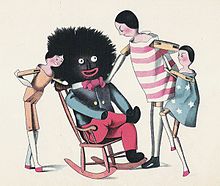

The golliwog, also spelled golliwogg or shortened to golly, is a doll-like character, created by cartoonist and author Florence Kate Upton, which appeared in children's books in the late 19th century, usually depicted as a type of rag doll. It was reproduced, both by commercial and hobby toy-makers, as a children's soft toy called the "golliwog", a portmanteau of golly and polliwog,[1][2][3] and had great popularity in the Southern United States, the United Kingdom, South Africa and Australia into the 1970s.
The golliwog is controversial, being widely considered a racist caricature of black people,[4][5] alongside pickaninnies, minstrels, and mammy figures. The doll is characterised by jet black skin, eyes rimmed in white, exaggerated red lips and frizzy hair, based on the blackface minstrel tradition. Since the 20th century, the word "golliwog" has been considered a racial slur towards black people.[6] The Jim Crow Museum of Racist Memorabilia described the golliwog as "the least known of the major anti-black caricatures in the United States".[7] Changing political attitudes with regard to race have reduced the popularity and sales of golliwogs as toys. Manufacturers who have used golliwogs as a motif (e.g. Robertson's marmalade in the UK) have either withdrawn them as an icon or changed the name. Alternative names such as golly and golly doll have also been adopted due to association with the racial slur wog, which many dictionaries say may be derived from golliwog.[8][9][10][11]
- ^ Harper, Douglas. "golliwog". Online Etymology Dictionary.
- ^ "golliwog". Oxford English Dictionary (Online ed.). Oxford University Press. (Subscription or participating institution membership required.)
- ^ "golliwog". Lexico Dictionaries (Powered by Oxford). Archived from the original on 16 January 2020. Retrieved 16 January 2020.
- ^ Cite error: The named reference
timeswas invoked but never defined (see the help page). - ^ Varga, Donna; Zuk, Rhoda (June 2013). "Golliwogs and Teddy Bears: Embodied Racism in Children's Popular Culture". The Journal of Popular Culture. 46 (3): 647–671. doi:10.1111/jpcu.12042.
- ^ Pilgrim, David. "The Golliwog Caricature - Anti-black Imagery". www.ferris.edu. Retrieved 25 April 2023.
- ^ Pilgrim, David (2000). "The Golliwog Caricature". Ferris State University. Retrieved 23 October 2018.
- ^ "Definition of 'wog'". Retrieved 16 September 2019.
- ^ "Definition of wog". Retrieved 16 September 2019.
- ^ "wog". Retrieved 16 September 2019.
- ^ "Wog". Your Dictionary. 24 October 2017. Retrieved 24 October 2017.